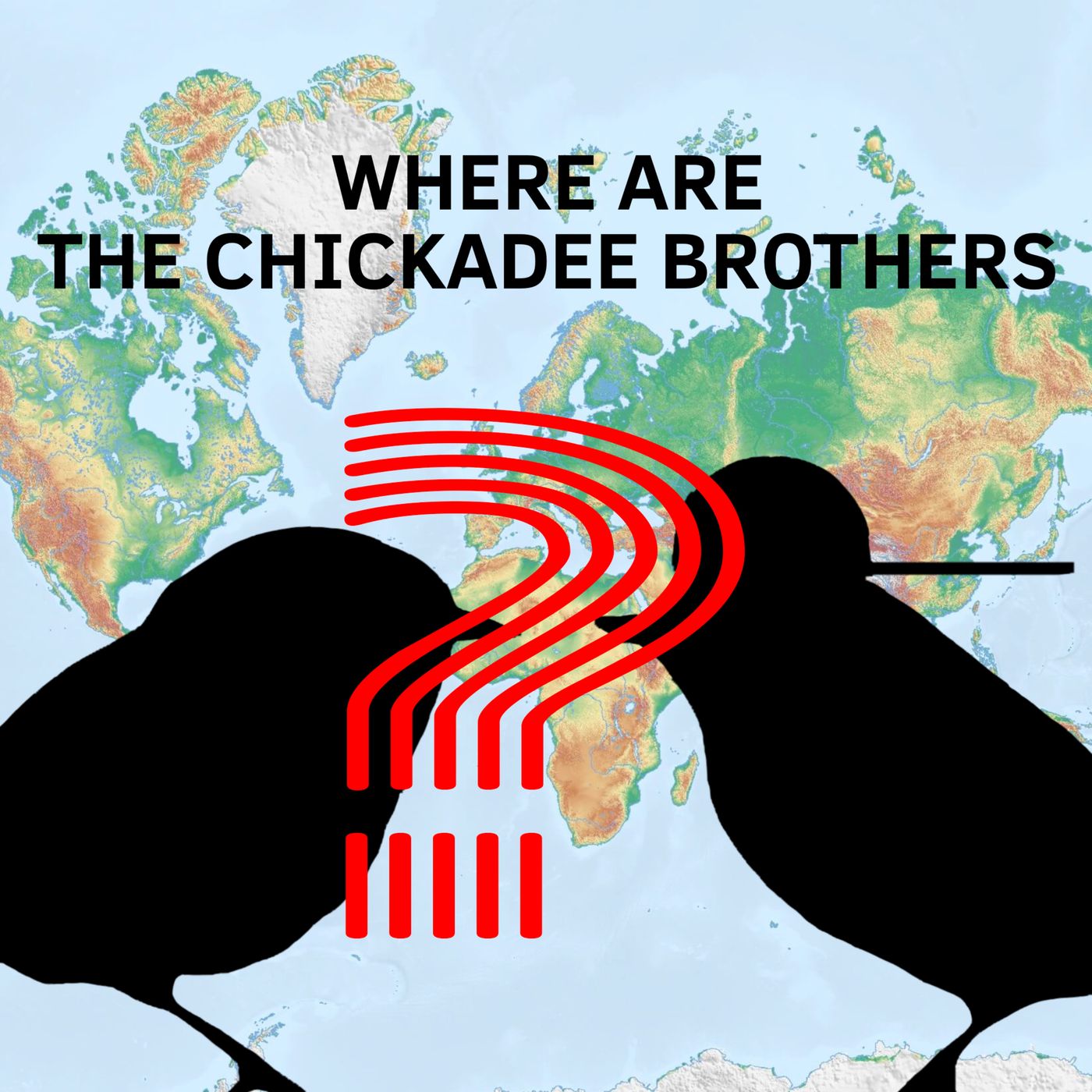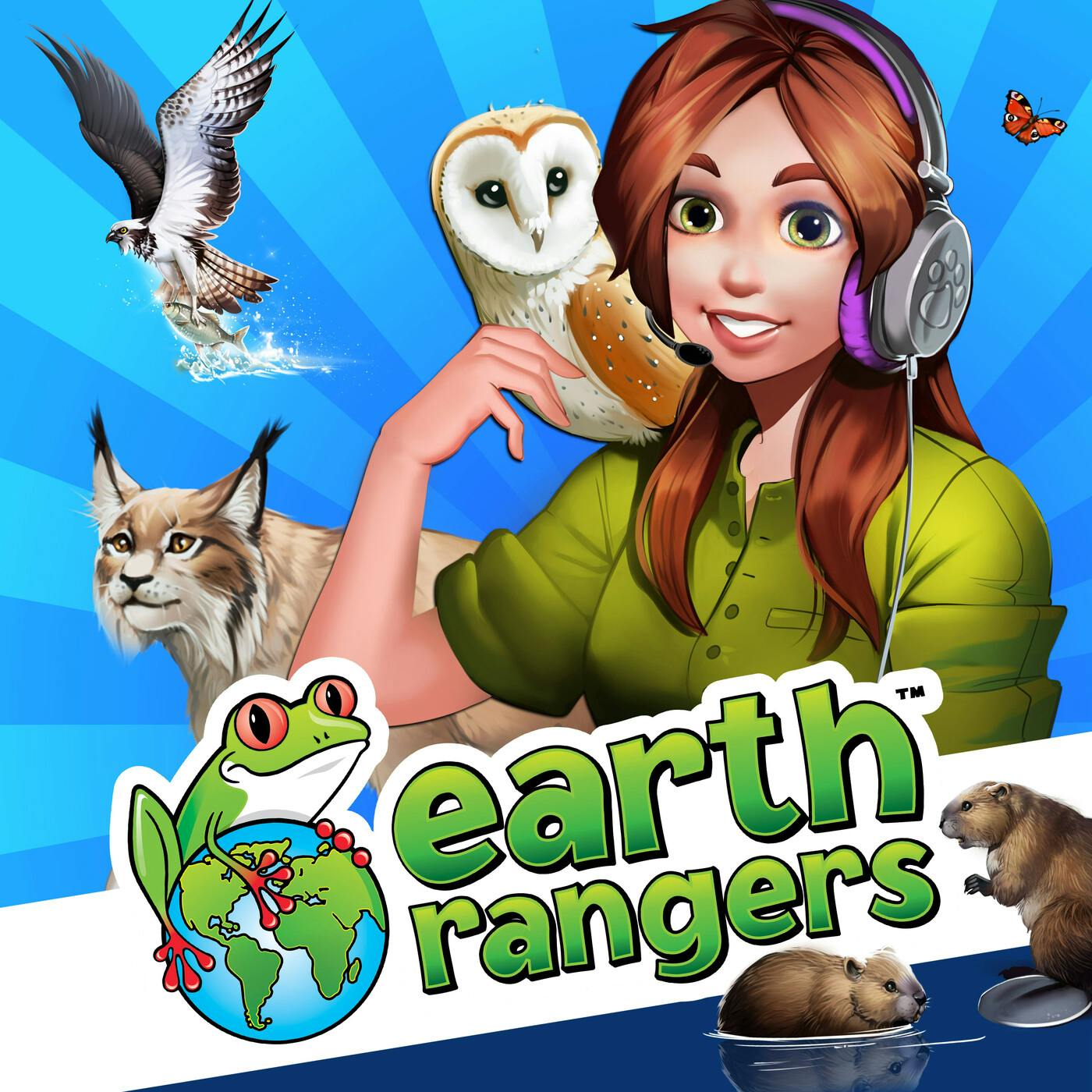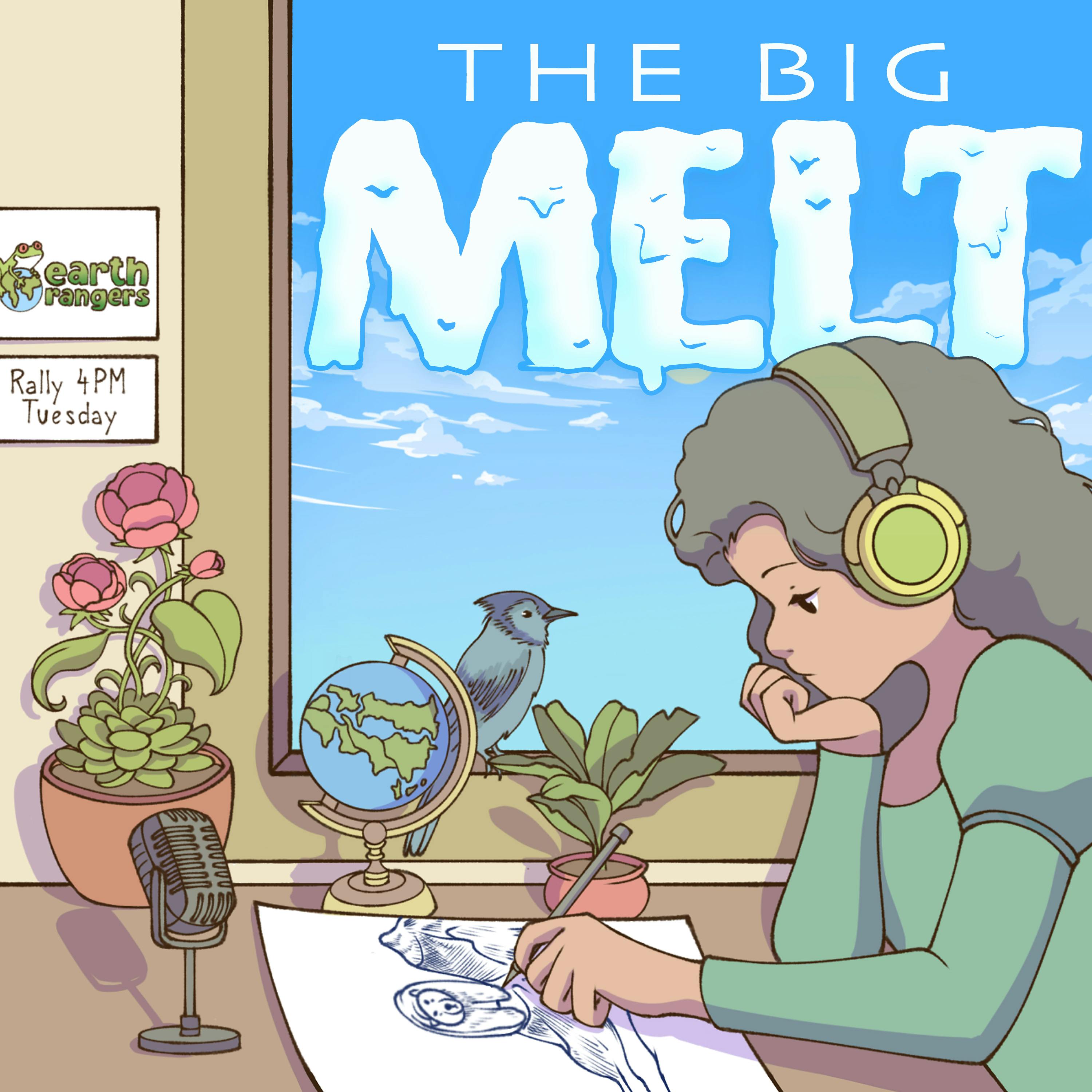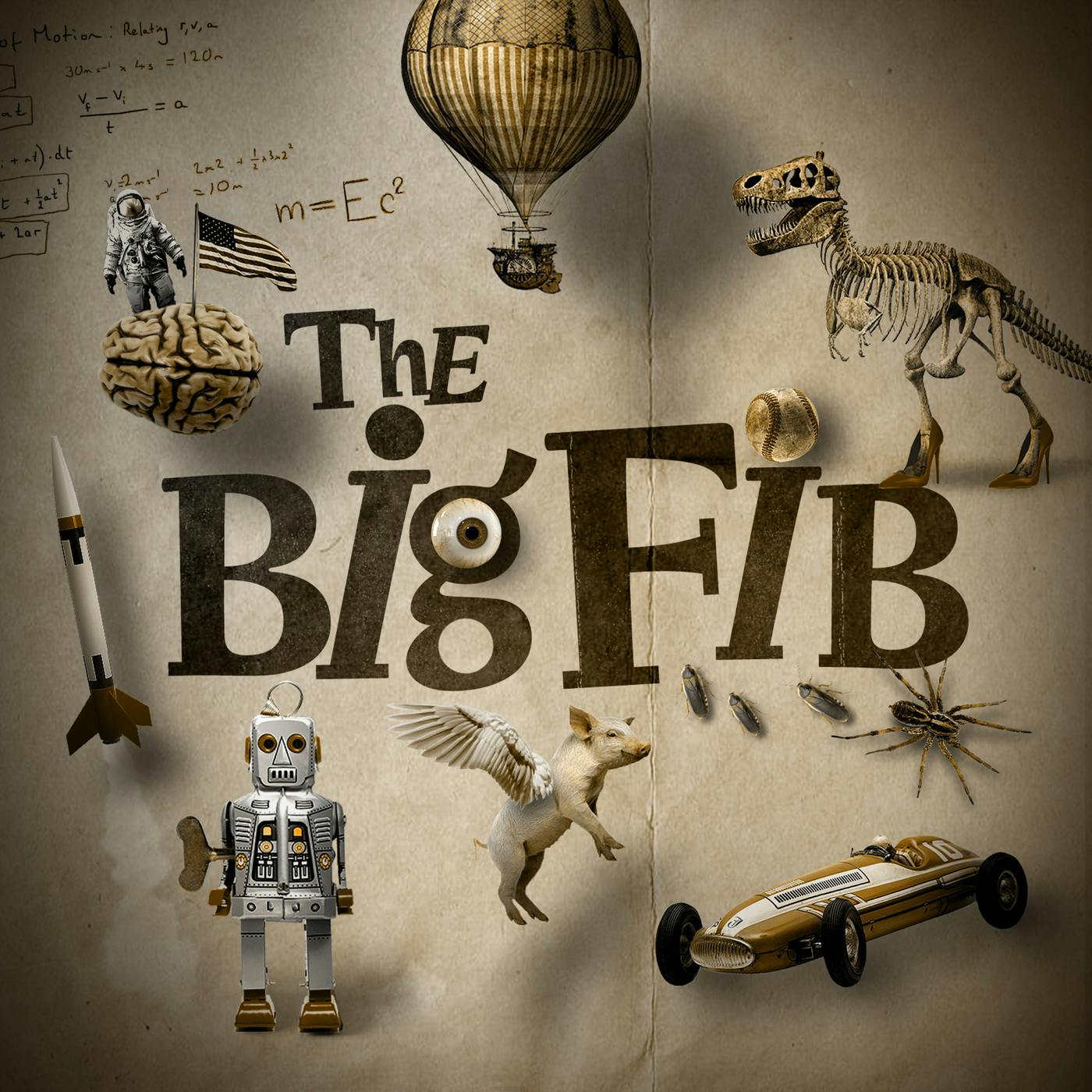.jpeg)
Kingdom: Animalia - A Zoology Podcast for Kids
This is a for-kids-(and adults)-by-kids-(and chickadees) animal podcast. In every regular episode, your host, Devon, and podcast-overthrowal-plotting chickadee co-hosts, Chet and Cap, will dive into all the facts about one species of animal with jokes, fun facts, and quizzes along the way. Every third-ish episode is our game show, Animalia Fake!, in which there are three rounds with four outrageous animal facts; one of those facts is so outrageous it’s an Animalia Fake (it’s not true), and you have to guess which it is.
You can send in questions and episode suggestions to animals@kapods.org, and my website is https://kapods.org/animals. So what are you waiting for? Let’s explore this amazing Kingdom: Animalia.
New episodes every 1–2 months.
Kingdom: Animalia - A Zoology Podcast for Kids
American Crow
Time to learn about those crafty corvids
______________________
Did you know that American Crows are as smart as 7–10-year-old humans? Are crows black, blue, or purple? What do crows eat? How do they always know when it's trash day? What would a crow get you for the holidays? Today with your host, Devon, and co-hosts, Chet and Cap, you will learn everything there is to know about the American Crow, Corvus brachyrhynchos.
Further Reading (Experiments):
Other Links:
If you have any questions, comments, episode suggestions, or verification that I’m not just talking into the void, please send them in (links below)! It really means a lot. Also, if you like this podcast, please share it with someone else who might!
Get in Touch: animals@kapods.org or kapods.org/contact
Visit My Website: kapods.org/animals
Follow in Your Favorite App: kapods.org/animals/follow
**Psst! Hey, you! It’s Chet and Cap! Do you have any questions for us? Just head over to kapods.org/acb and send a voice message or email with your questions, and we’ll answer them on an Ask the Chickadee Brothers episode of this podcast!**
Until next time, keep exploring this amazing Kingdom: Animalia.
This podcast is made by Kingdom: Animalia Podcasts.
[Devon] Hello and welcome to this Halloweeny first episode of Kingdom: Animalia! [Chet] Chicka Vah hah Chicka ha! [Devon] I’m your host Crow and these are my co-hosts… [Chet] Chicka Count Chickula! [Devon] …and… [Cap] Chicka Frankenchickadee! [Devon] Heh heh, just kidding. Those are just our Halloween costumes. Let’s try that again. I'm your host Devon, and these are my co-hosts… [Chet] Chicka Count Chickula! [Devon] …and —wait what?… [Cap] Chicka Frankenchickadee! [Devon] No this is Chet dressed as Count Chickula and Cap dressed as Frankenchickadee. Happy Halloween podcast listeners! What are you going as? Before we start today’s episode I’d like to ask you another question. [Cap] Chicka What is Chicka it? [Devon] It’s not for you Cap, it’s for the listeners. So, how old are you? Are you seven? Seven to ten? Well if you are, then today’s animal is as smart as you are. Today on the first episode of Kingdom: Animalia - A Zoology Podcast for Kids, you might already know this if you read the episode title, is about the American Crow, Corvus brachyrhynchos, one of the world’s smartest birds. Enjoy.
[Devon] I know that most of you probably know what a crow looks like, so let me test your knowledge. So is the American Crow A), Completely black, B), Black with a purple or blue sheen or C), Dark blue. [Chet] Chicka A! [Cap] Chicka D! Cap Chicka Colored! [Devon] Cap colored?!? What does that even–Whatever. The answer is, drumroll please,… B! Crows technically are black but in certain light their feathers can have a pretty purple or blue sheen to them. They’re almost completely black except that they have brown eyes (brown with black pupils) which are actually bright blue before they fully fledge (grow all their adult feathers).
Continuing on with their description, American Crows are large, (fifteen point eight to twenty point nine inches or forty to fifty-three centimeters from head to tail to be exact) (males and females being the same size), have medium length legs, a somewhat long and thick neck, and a long, thick and straight bill. Their wingspan is about thirty-three point five to thirty-nine point four inches or eighty-five to one-hundred centimeters wide. The primary feathers (the feathers closer to ends of the wings I’ll link a photo in the transcript {click to go to image}) on their wings spread out like fingers when they're flying which help them reduce drag (vultures have those too). They have a fairly long tail that’s shaped like a fan unlike a raven’s which looks more like a wedge shape, but we’ll get to that later in the episode. Let’s do another multiple choice question. [Chet] Chicka B! The Chicka answer’s B! [Devon] B? I haven’t even given you the options, Chet! Okay do American Crows weigh A), Eleven point two to twenty-one point nine ounces, B), thirty point six to forty ounces or C), fifty point seven to sixty point four ounces? [Cap] Chicka C! They’re Chicka big birds! [Chet] Chicka A? [Cap] Chicka A, Chet?? Chicka A?? Chicka I bet Chicka my cap Chicka you’re wrong! [Devon] Well Cap it seems like you owe Chet a cap because the answer is A! [Cap] Chicka What? No! [Chet] Chicka Hand it Chicka over, Cap. [Cap] Chicka No! [Devon] While Chet and Cap argue about this, let's take a quick breather. [Chet and Cap under Devon] Chicka Rrrrr… Chicka No!
[Devon] Hello listeners! It’s me, Devon, here to give you a message. If there’s a species of animal you really want to hear about on this show then you can send your suggestions to kingdom.animalia.pod@gmail.com or use the contact form on my website. The next two episodes are holiday themed, but after that I’ll do a listener suggestion as often as possible. You can also use the email and contact form to send me questions about the show. There will be more info about sending me emails and more at the end of the show. Now back to American Crows.
[Cap] Chicka Cap here. Chicka Also send Chicka emails subject Chicka line “The Chickadee Brothers” Chicka to give Chicka me and Chicka Chet tips Chicka for taking Chicka over the Chicka show. Chicka Wah hah Chicka hah.
[Devon] Welcome back to Kingdom: Animalia - A Zoology Podcast for Kids, the show where we focus on one species of animal every episode. I’m your host Devon and these are my co-hosts… [Chet] Chicka Chet… [Cap] … Chicka And Cap! [Devon] …And today we’re talking about–[Cap] Chicka Caps! [Devon] No! American Crows! Now it’s time to talk about how and what they eat.
American Crows are omnivores, and that means A), They eat meat, B), They eat plants and/or Fungi and/or Algae or C), All of the above. [Chet and Cap] Chicka C! [Devon] You’re both correct! To be an omnivore means you eat both plants (and/or fungi and/or algae) and meat! You’re omnivores too, Chet, and Cap. Though omnivores eat both plants and meat it doesn’t necessarily mean they’ll eat everything but crows do. They eat insects, spiders, snails, worms, frogs, small snakes, shellfish, carrion (dead animals), fish, garbage, bird eggs and young, seeds, nuts, grain, fruits, and even pet food! They’ll also eat from crops hence why they have scarecrows (which don’t actually work because the crows figure them out!). They are opportunistic, meaning they do it when they have–[Cap] Chicka Caps!! [Devon] No! They do it when they have–[Chet] Chicka Birdseed!! [Devon] No! No and no! I’m going to have to mute you two so I can finish. There. They do it when they have the opportunity to so they can take advantage of new sources of food. (Let me unmute you two…) They’re mainly ground feeders but–[Chet] Chicka I ate Chicka from a Chicka ground feeder Chicka a couple Chicka of times! [Devon] It’s kind of different. They feed (eat) on the ground; but crows sometimes feed in trees. They’re foragers, but also scavengers so they’ll eat at dumps (for quote-on-quote “edible” trash), and by the road (for roadkill). When there’s a snail, clam or nut they can’t crack they’ll drop it on the ground from far up so the impact will crack it. On shores they’ll dig holes for clams, and they’ll also distract animals who catch fish or other food to steal it.
[Devon] Next let’s talk about–[Cap] Chicka Caps! [Devon] No, behavior. Crows will–[Cap] Chicka Get caps! [Devon] No! Don’t make me regret unmuting you Cap. Crows will gather in large foraging flocks in winter, and large groups will congregate in trees at night to sleep (roosting). American Crows, like all crows, are highly social and the largest flocks can get up to, A), One thousand, B), One Million, or C), One Billion birds? [Cap] Chicka B! [Chet] Chicka A? [Devon] You’re right Chet! They don’t get up to one-billion or even one-million but up to one-thousand crows strong! [Cap] Chicka Again Chet?!? Chicka You got Chicka it right Chicka again?!? [Devon] Okay. Back to behavior and–hey! Cap! Stop! No Cap! Hand back over the answer sheet–No! Give it back!
Woof. Okay I locked Cap out of the recording studio for a little while, so let’s finish talking about behavior. As you might know by now crows are very smart but they’re also curious and mischievous and good at learning and problem solving. Lots of times they’re the bird equivalent of racoons, stealing from trash cans. They can be very aggressive to larger birds chasing away hawks, eagles, vultures, owls and herons, a behavior called mobbing when a group of relatively small animals chases away a larger typically threatening animal.
[Devon] Now, I think a lot of you North American listers know the characteristic loud nasal “caw” of the increasingly American Crow but did you know that they have over twenty different calls? There are many variations of the “caw” plus they have some variations of the rattling sound numerous Corvids make by clacking their bills. You may not think of crows singing but they have a song like sequence of hoarse coos, caws, rattles and clicks. It can last for numerous minutes and is “sung” quietly.
[Devon] Do you think crows and ravens look identical? Well now I’m going to teach you a crash course on Crows Vs Ravens.
[Cap] Chicka Difference number Chicka one: caps. [Devon] No! Size! Ravens are larger than crows, crows being just bigger than a pigeon while ravens are more the size of a red-tailed hawk. Common Ravens are about twenty-four to twenty-seven inches or sixty point nine six to sixty-eight point five eight centimeters long from head to tail and have a wingspan of three and a half to four feet or one to one point two meters wide, and are nearly twice as heavy as crows at forty ounces so think of ravens as crow’s larger cousines. Fun fact: ravens are the largest passerine birds.
[Cap] Chicka Difference number Chicka two: [Devon] Shape. Ravens have a larger bill with a more distinct curve, and as hinted at in our description crows have fan shaped tail while ravens have a more wedge shaped tail. Ravens also have longer quote-on-quote “fingers” on their wings.
[Cap] Chicka Difference number Chicka three: [Devon] Flying. When ravens fly their wings sometimes make a “swishing” or “whooshing” sound while crow flight is normally silent. Corvids have a flight style of flapping a lot, and then gliding for a short period of time to conserve energy. Crows don’t usually glide for more than a few seconds while ravens will glide for longer without flapping, so if you see a large black corvid gliding for more than a few seconds it’s probably a raven and not a crow. Ravens also tend to do barrel rolls while flying and sometimes even fly upside down for a little while, which is rare for crows.
[Cap] Chicka Difference number Chicka four: [Devon] Habitat. Crows are increasingly common in populated urban areas while ravens are rare in cities, so if you see a large crow in a big city it probably is just that, a large crow, and not a raven.
[Cap] Chicka Difference number Chicka five: [Devon] Calls. As I already covered, American crow's most commonly heard call is the loud nasal sounding “caw” while ravens have a hoarse raspy croaking call. Now I’m going to play the sound of an American Crow and a Common Raven and you’ll have to guess which is the crow and which is the raven. Call number one: {Common Raven call} …and now call number two: {American Crow call}. So what’s your guess? Which one’s the crow? Cap? [Cap] Chicka Two! [Devon] Chet? [Chet] Chicka Two! [Devon] The American Crow is, drumroll please… Call number two! You’re both right! Congrats!
This concludes our crash course on Crows Vs Ravens.
[Devon] Now we’re going to talk about where American Crows live. [Cap] Chicka They live Chicka in America! …Chicka Obviously. [Devon] Well more specifically… American Crows breed from southern Alaska, central interior Canada and southern Newfoundland to southern California, Gulf Coast, and Florida. They winter in northern to southern Canada and along the Pacific Coast north of southern Alaska. They’re very common and in some places such as California, where I live, they’re permanent residents. American Crows are common in fields, open woodlands, and forests. They really thrive around people (think of them as the Corvid counterparts of city pigeons), and are commonly found in agricultural fields, parking lots, yards, sports fields, roadsides, towns, cities and garbage dumps. You can look at a range map through my work cited page which is linked on my website on the page for this episode, and in the show notes.
Now onto the topic all American Crows wish didn’t exist… Predators. [Chet] Chicka Eek! [Cap] Chicka Aah! [Devon] Predators include large hawks such as Red-tails, Great-horned owls, [Cap] Chicka Oh, no! [Devon]…racoons, humans, snakes, [Chet] Chicka Eek! [Devon]…and domestic cats, [Chet] Chicka Not them [Devon]…but few animals eat healthy, adult, American Crows. [Cap] Chicka Pheoo.
[Devon] Now onto nesting; and note: Birds don’t usually LIVE in their nests as cartoons have depicted. Nests are normally just for eggs and chicks and the birds only sleep in it if they’re chicks or if they're a parent on nest duty for the night. There is one exception though: the Monk Parakeet. They create large nest “apartments” that they do sleep in. With that in mind, let’s continue. American Crows nest in trees and large shrubs about ten to seventy feet or three point zero four eight to twenty-one point three three six meters above the ground, usually in a vertical fork, or at the base of a branch right up against the trunk if it’s a tree. They don’t really nest on the ground or on building ledges unlike some other birds. The nest, which is built by both the male and the female, is a large, and bulky, basket of sticks, twigs, strips of bark, weeds, and, mud, lined with softer materials like grass, moss, feathers and plant fibers. [Devon] American Crow courtship (courtship is where animals attract mates,) is usually on the ground or in a tree. First the male crow faces the female, fluffs up his body feathers, partially spreads his wings and tail, and repeatedly bows as he sings a rattling song. If the female is impressed, they become a crow couple. Mated pairs perch close together, touch bills and preen each other's feathers to strengthen their bond. When crow chicks fully fledge they usually stay with their parents until they can mate, to take care of their younger siblings. The immatures can stay for up to six years and the family size can be up to: A), Fifteen, B), Twenty or C), Thirty? [Chet] Chicka B? Twenty? [Cap] Chicka Trick question! Chicka One-hundred! [Devon] No Cap it’s not a trick question, and no Chet, it’s not B. It's A: Fifteen! Actually EIGHTY percent of observed American Crow nests had immature helpers! Some young crows will leave their parents’ nest and help older siblings in their nests. Sometimes in food rich areas and especially in Winter, as briefly mentioned, American crows will gather in large foraging flocks of all ages. The crows in any given flock change daily.
[Devon] Remember when I told you that crows are very smart? Well now let’s talk about that intelligence. If you had a really hard nut, say a walnut that you couldn’t crack, what would you do? Would you by any chance wait until a red light, then drop it on the street, leave it there letting the cars run over it, and then pick it up when the light’s turned red again? Probably not but some crows do. It’s pretty smart for an animal to recognize that cars stop on red lights and go on green lights. As I mentioned earlier in the episode they’ll steal food from animals who already did the hard work of getting the food, but I didn’t tell you how. They'll work together. One or more crows will distract the predators while other crows steal the food. Sometimes If there are other birds around like gulls or even other crows they’ll pretend to hide their food in one place but when the other birds are looking for it there they’ll hide it somewhere else. Also if they’re eating something and another crow comes along they might play dead to make the other crow think it’s poisonous, and not eat it. They can actually figure out how to complete a complicated series of events in order to solve a puzzle! Crows can remember garbage truck routes, recognize which kids drop food to eat, and who purposefully feeds them! They’ll even give you little things that they found and thought looked pretty if they like you. (Note: Crows, Ravens and Magpies really like to collect shiny things). They know the neighborhood pet dogs, and might even play with friendly ones. Crows and ravens are actually very playful and there are records of crows sliding down icy car windshields in Winter, like slides. Just recently scientists have learned how smart crows and ravens really are. Common Ravens are actually the smartest birds in the world! Crows are able to understand analogies, perform self control, make and use tools, play tricks, teach each other new things and as I already mentioned, play. All of these are traits that we associate with intelligence. Crows will actually hold funerals (it’s actually thought to be a method of figuring out why they died so they can stay away from it, or mob it if it’s a predator.
[Devon] Have you ever held a grudge? Well crows do. There was an experiment where a team of researchers from the University of Washington caught American Crows in nets on campus while wearing a caveman mask, and then released them again. When the researchers walked around on the campus later, wearing the same caveman mask the crows loudly cawed at, and even dive-bombed the researchers. And then more than ten years later, yes more than ONE DECADE after the crows were caught and released half the crows STILL loudly cawed at, and dive-bombed the researchers. That means they’re able to remember faces and hold grudges for years! You remember how in the beginning of the episode I said that crows are as smart as you if you’re seven to ten years old? Well that is if you’re a human and not a Common Raven and if that’s true I’m really impressed by your technological abilities. Now I’m going to tell you how scientists [Cap] Chicka Built caps! [Devon] Seriously Cap? You’ve been quiet, and I was *cough* hoping you'd stay that way *Cough cough*. [Cap in background] Chicka Are you Chicka sick? [Devon] Now I’m going to tell you how scientists found that out. The experiment went like this: the crows had to figure out how to get floating food rewards out of tubes of water by putting heavy objects in, to raise the water level. The crows showed the ability to choose objects that would sink instead of float, and solid ones rather than hollow ones. They were able to choose a tube with a high water level to begin with over one with a low water level so they could get food with the least amount of work – and a tube of water and not one with sand where the level wouldn’t rise.. They were able to fill the tubes with enough rocks or different heavy objects to bring the food close enough for the crows, hungered from all of that brainpower, to eat. According to a study the University of Cambridge did in twenty twelve, the experiment was very hard for kids under seven while kids seven to ten years old were able to figure it out just as well as the clever crows. So since the crows were better than kids under seven and as good as kids seven to ten years old they’re in some aspects as smart as seven to ten year olds. I’m eleven so I’m barely smarter than my neighborhood crows.
[Devon] Who’s ready for some FUN FACTS?!?
[Chet] Chicka Fact number Chicka one: [Devon] American Crows as I already mentioned congregate in large numbers in winter to sleep in communal roosts, but what I didn’t tell you is that the roosting groups go from a few hundred to TWO MILLION crows. Some crow roosts have been forming in the same general area for well over ONE-HUNDRED YEARS!
[Chet] Chicka Fact number Chicka two: [Devon] American Crows can’t breed until they’re two years old.
[Chet] Chicka Fact number Chicka three: [Devon] Despite their tendency to eat roadkill, American Crows are not meat specialists, and carrion is only a small portion of their diet. Though they have large bills a crow couldn’t even puncture the skin of a Gray Squirrel. They have to wait for another animal to open the carcass for them.
[Chet] Chicka Fact number Chicka four: [Devon] As I mentioned earlier in the show crows will eat, yes, bird eggs and young. [Chet] Chicka Ahhh! [Devon] I know Chet. And even if a bird's nest is well hidden, sadly the young and/or eggs will never be safe from those crafty crows. Crows will sometimes follow adult birds to find their nests and their tasty young, and eggs. Also as I mentioned earlier, they’ll steal food from other animals. One group of crows was seen distracting a river otter to get the fish that it had done all the hard work to catch. A different group of crows followed Common Mergansers –a type of diving duck– to catch minnows that the ducks were chasing into shallow water. Think of crows like bird pirates. [Chet] Chicka Arr!!
[Chet] Chicka Fact number Chicka five: [Devon] Tools! As I’ve talked about, crows make tools. Here are some examples: one captive crow used a cup to carry water to a bowl of dry food, shaped a piece of wood and then stuck it into a hole in a fence post to search for food, and broke pieces off a pinecone to drop on tree climbers near a nest to scare them off.
[Chet] Chicka Fact number Chicka six: [Devon] The oldest wild American Crow recorded was at least seventeen years and five months old when it was photographed in Washington State so it might’ve lived older. The oldest American Crow to ever live was a captive one who –get this– lived to FIFTY-NINE years old! Now that’s one old crow.
[Devon] Now let’s do the Glossary where I’ll explain some words from the show you and exceptial younger listeners may not know.
Word number one: Corvids: “Corvids” is a term for birds in the family Corvidae which includes crows, ravens, rooks, jays, magpies and nutcrackers. The bird, not the thing you use to crack nuts.
Word number two: Passerines: “Passerines” or “Passeriformes” is an order of birds which is frequently called songbirds though not all Passerines have a true song and lots of non-Passerines have songs. They’re also sometimes called perching birds but a lot of non-Passerines perch too.
Word number three: Agriculture: Agriculture is where you grow food and/or farm animals to put it simply.
Word number four: Preening: Preening is when birds rearrange, pull out old and depending on the species, spread oil around, their feathers from a special gland on their tail to waterproof themselves.
Word number five: Analogy: An analogy is where you use one thing to represent another kind of related thing. Example: “Looking for a needle in a haystack” is an analogy for something being really hard to find, like a needle in a haystack.
[Devon] So we’ve come to the end of the first episode of Kingdom: Animalia. I can’t believe we’ve made it so far. Even I’ve learned a lot about my black, crafty, corvid neighbors. Want to learn more about American Crows? You can look at my “Works Cited Page” to see the resources that I got my information from, which I linked in the show notes, and on my website at kingdom-animalia-pod.webador.com. The page for this episode is at /episodes/episode-01-american-crow. If you liked this episode you might want to look at the crow episode of Cool Facts About Animals and older kid listers might like the raven episode of the Species podcast. As I said earlier you can send me animal episode suggestions, and questions at kingdom.animalia.pod@gmail.com, and on the contact page of my website. You can also send me your answers to the riddle for the next episode. So here it is: “I’m related to chickens but my tail’s not the same, my calls sound like someone eating food, now can you guess my name?” So any guesses? Send them in and I’ll tell you if you’re right, but if you’re wrong you’ll have to wait until the next episode which comes out at the end of November to find out. If I get your permission I’ll shout you out on the episode if you got it right. Good bye for now, don’t let the crows steal your trash, eat plenty of candy, and until next time, keep exploring this amazing Kingdom:, Animalia. Bye! [Chet and Cap] Chicka Bye!!
Chicka The Chickadee Chicka Brothers. *Snicker*
Podcasts we love
Check out these other fine podcasts recommended by us, not an algorithm.

Where Are the Chickadee Brothers?
Kingdom: Animalia Podcasts
Amazing Wildlife: A San Diego Zoo Podcast
iHeartPodcasts
Earth Rangers
GZM Shows
Short Wave
NPR
Unexplainable
Vox
Science Friday
Science Friday and WNYC Studios
The Big Melt
Gen-Z Media
How Wild
NPR
Six Minutes
GZM Shows
Radiolab
WNYC Studios
The Big Fib
GZM Shows
The Natureverse: Becoming Mother Nature
GZM ShowsThe Show About Science
Nate | The Company Making Podcasts
Tai Asks Why
CBCCool Facts About Animals
Cool Facts About Animals Podcast

